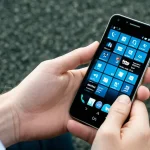Key Functions of Smartphones in the UK’s Digital Life
Smartphone functionality in the UK has become integral to everyday life, driving the ongoing digital transformation. These devices streamline daily routines by offering instant access to communication, navigation, and productivity tools. For example, UK users commonly rely on smartphones to manage banking, book transport, and access government services such as digital health records and tax submissions.
Statistics reveal that smartphone adoption rates in the UK now exceed 80%, reflecting their importance in harnessing technology benefits across society. With such widespread use, smartphones act as portals to essential services—like the NHS app for healthcare appointments, the DVLA’s digital vehicle management, and public transit updates via mobile ticketing apps. These functions not only save time but also improve accessibility and convenience.
Also to see : How Can Smartphones Influence Evolving Computing Trends in the UK?
Moreover, smartphones facilitate staying connected through social networks and messaging while supporting work flexibility via mobile email and cloud services. This broad functionality smooths daily life and underpins the UK’s ambitious goals in digital transformation. By integrating multiple services into a single device, smartphones enhance efficiency and empower UK residents to engage fully with an increasingly digital society.
Integration with Essential UK Services
Accessing vital digital tools seamlessly
Also to discover : How Can Smart Technology Revolutionize Communication in the UK?
One of the key advantages of advanced robot hoovers in the UK lies in their integration with digital services UK, including mobile banking, NHS apps, and other government digital initiatives. These integrations go beyond cleaning, enhancing convenience in everyday life.
Access to FinTech and Mobile Banking
Robot hoovers equipped with smart assistants can now interact with mobile banking services. Users can, for example, receive notifications about bank balances or transaction alerts through their device’s speaker or smartphone linked to the robot. This hands-free functionality in digital services UK allows busy individuals to multitask efficiently while managing finances securely.
Use in NHS and Healthcare Digital Services
Integration with NHS apps takes smart cleaning devices further by linking health reminders or updates directly to the user. Robot hoovers can remind patients to take medication or notify them of NHS appointment changes. This capability enhances users’ engagement with healthcare digital services, reducing missed appointments and improving adherence to treatment schedules.
Interaction with Government and Public Sector Portals
Through government digital initiatives, robot hoovers can connect users to essential public sector portals. Features may include alerts for council tax payments or updates from local authorities, integrated neatly into daily routines. By embedding such services, digital services UK become truly accessible, making governmental tasks less burdensome through a familiar and interactive platform.
Smartphones as Connectors in the UK’s Social and Economic Fabric
Smartphones play a pivotal role in UK social connectivity, bridging distances and supporting everyday interactions. They enable people to maintain both personal and professional connections with remarkable ease. Mobile communication trends in the UK show a growing reliance on smartphones for instant messaging, video calls, and social media engagement, fostering stronger bonds even when physical meetings aren’t possible.
Beyond personal use, smartphones significantly aid local businesses. Innovative local business apps UK empower small enterprises to reach customers more efficiently, manage orders, and offer tailored promotions. These platforms actively contribute to community economics, helping shops and services thrive through enhanced visibility and convenience.
During major events or emergencies, smartphones become indispensable tools. They allow rapid dissemination of crucial updates, coordination among responders, and ensure individuals stay informed and connected. This dual role of smartphones—as a social hub and economic enabler—reflects their integral place in the UK’s fabric, shaping how communities interact and evolve.
Advancements in Smart City Technology and Urban Living
Smart city UK initiatives increasingly leverage smartphone integration to enhance urban life. This integration connects residents directly to urban infrastructure through their mobile devices, transforming how people interact with transport, payments, and navigation systems. For example, many UK cities now support contactless payments and real-time public transit updates accessible via smartphones, improving convenience and reducing wait times.
IoT mobile integration plays a pivotal role by linking sensors, cameras, and street lighting with residents’ phones, enabling seamless data exchange that powers smarter decision-making. Tracking transportation efficiency or managing energy use becomes more responsive and user-focused. Urban technology trends UK emphasize these connected solutions to foster sustainability and accessibility.
Beyond convenience, this technology significantly impacts accessibility. Smartphone-enabled navigation and transport services assist those with disabilities, while mobile platforms provide inclusive access to city amenities. By integrating IoT with mobile devices, urban technology trends UK pave the way for smarter, more adaptive cities that prioritize quality-of-life improvements for all residents.
Emerging Trends in Mobile Innovation within the UK
The mobile innovation UK landscape is rapidly evolving, driven primarily by widespread 5G adoption. The 5G rollout across the UK has fundamentally changed user experience by delivering faster speeds, lower latency, and improved connectivity. This expansion benefits not only consumers but also businesses that rely on robust mobile networks for real-time applications and services.
Alongside network improvements, the UK is witnessing a surge in UK app development, with developers focusing on creating locally tailored apps that address specific consumer needs. These apps span sectors like finance, health, and entertainment, showcasing how mobile innovation UK is becoming more customer-centric and solution-driven.
Another exciting dimension to this innovation is the integration of AI and augmented reality technologies into smartphones. AI-powered features such as voice assistants and predictive text enhance user convenience, while augmented reality applications offer immersive experiences for gaming, shopping, and education. This combination of AI-powered smartphone features and AR is carving out new possibilities that align with the digital lifestyle of UK users.
Overall, these trends highlight a dynamic phase in mobile innovation UK, where infrastructure, software, and intelligent technologies converge to create more powerful and engaging mobile experiences.
Quality-of-Life Improvements Driven by Smartphones
Smartphones have significantly boosted digital inclusion UK, making technology accessible to diverse groups, including older adults and people with disabilities. Features like voice control, screen readers, and customizable displays enhance smartphone accessibility, empowering users who previously faced barriers. This progress is vital for narrowing gaps in digital skills and access among UK populations.
In everyday life, a suite of everyday convenience apps UK greatly simplifies tasks. Public transport apps offer real-time updates and journey planning, reducing stress during commutes. Shopping apps provide quick access to goods, facilitating contactless payments and home deliveries, while utility apps enable easy management of bills and services from anywhere.
Together, these tools contribute to closing the digital divide within UK regions, especially between urban and rural areas where access to physical services may be limited. By providing essential functions directly through smartphones, these advancements enhance independence and convenience. This evolution demonstrates how improving smartphone accessibility and expanding digital inclusion UK are practical steps toward a more connected, equal society.









